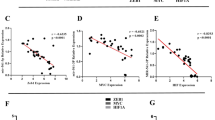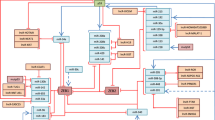Abstract
Estrogen effects on mammary epithelial and breast cancer (BC) cells are mediated by the nuclear receptors ERα and ERβ, transcription factors that display functional antagonism with each other, with ERβ acting as oncosuppressor and interfering with the effects of ERα on cell proliferation, tumor promotion and progression. Indeed, hormone-responsive, ERα+ BC cells often lack ERβ, which when present associates with a less aggressive clinical phenotype of the disease. Recent evidences point to a significant role of microRNAs (miRNAs) in BC, where specific miRNA expression profiles associate with distinct clinical and biological phenotypes of the lesion. Considering the possibility that ERβ might influence BC cell behavior via miRNAs, we compared miRNome expression in ERβ+ vs ERβ− hormone-responsive BC cells and found a widespread effect of this ER subtype on the expression pattern of these non-coding RNAs. More importantly, the expression pattern of 67 miRNAs, including 10 regulated by ERβ in BC cells, clearly distinguishes ERβ+, node-negative, from ERβ−, metastatic, mammary tumors. Molecular dissection of miRNA biogenesis revealed multiple mechanisms for direct regulation of this process by ERβ+ in BC cell nuclei. In particular, ERβ downregulates miR-30a by binding to two specific sites proximal to the gene and thereby inhibiting pri-miR synthesis. On the other hand, the receptor promotes miR-23b, -27b and 24-1 accumulation in the cell by binding in close proximity of the corresponding gene cluster and preventing in situ the inhibitory effects of ERα on pri-miR maturation by the p68/DDX5-Drosha microprocessor complex. These results indicate that cell autonomous regulation of miRNA expression is part of the mechanism of action of ERβ in BC cells and could contribute to establishment or maintenance of a less aggressive tumor phenotype mediated by this nuclear receptor.
This is a preview of subscription content, access via your institution
Access options
Subscribe to this journal
Receive 50 print issues and online access
$259.00 per year
only $5.18 per issue
Buy this article
- Purchase on Springer Link
- Instant access to full article PDF
Prices may be subject to local taxes which are calculated during checkout





Similar content being viewed by others
Accession codes
References
Ambrosino C, Tarallo R, Bamundo A, Cuomo D, Franci G, Nassa G et al. (2010). Identification of a hormone-regulated dynamic nuclear actin network associated with estrogen receptor alpha in human breast cancer cell nuclei. Mol Cell Proteomics 9: 1352–1367.
Bardin A, Boulle N, Lazennec G, Vignon F, Pujol P . (2004). Loss of ERbeta expression as a common step in estrogen-dependent tumor progression. Endocr Relat Cancer 11: 537–551.
Bhat-Nakshatri P, Wang G, Collins NR, Thomson MJ, Geistlinger TR, Carroll JS et al. (2009). Estradiol-regulated microRNAs control estradiol response in breast cancer cells. Nucleic Acids Res 37: 4850–4861.
Blenkiron C, Goldstein LD, Thorne NP, Spiteri I, Chin SF, Dunning MJ et al. (2007). MicroRNA expression profiling of human breast cancer identifies new markers of tumor subtype. Genome Biol 8: R214.
Castellano L, Giamas G, Jacob J, Coombes RC, Lucchesi W, Thiruchelvam P et al. (2009). The estrogen receptor-alpha-induced microRNA signature regulates itself and its transcriptional response. Proc Natl Acad Sci USA 106: 15732–15737.
Chang EC, Frasor J, Komm B, Katzenellenbogen BS . (2006). Impact of estrogen receptor beta on gene networks regulated by estrogen receptor alpha in breast cancer cells. Endocrinology 147: 4831–4842.
Chendrimada TP, Gregory RI, Kumaraswamy E, Norman J, Cooch N, Nishikura K et al. (2005). TRBP recruits the Dicer complex to Ago2 for microRNA processing and gene silencing. Nature 436: 740–744.
Cicatiello L, Addeo R, Altucci L, Belsito Petrizzi V, Boccia V, Cancemi M et al. (2000). The antiestrogen ICI 182 780 inhibits proliferation of human breast cancer cells by interfering with multiple, sequential estrogen-regulated processes required for cell cycle completion. Mol Cell Endocrinol 165: 199–209.
Cicatiello L, Mutarelli M, Grober OM, Paris O, Ferraro L, Ravo M et al. (2010). Estrogen receptor alpha controls a gene network in luminal-like breast cancer cells comprising multiple transcription factors and microRNAs. Am J Pathol 176: 2113–2130.
Cicatiello L, Scafoglio C, Altucci L, Cancemi M, Natoli G, Facchiano A et al. (2004). A genomic view of estrogen actions in human breast cancer cells by expression profiling of the hormone-responsive transcriptome. J Mol Endocrinol 32: 719–775.
Croce CM . (2009). Causes and consequences of microRNA dysregulation in cancer. Nat Rev Genet 10: 704–714.
Dennis Jr G, Sherman BT, Hosack DA, Yang J, Gao W, Lane HC et al. (2003). DAVID: Database for Annotation, Visualization, and Integrated Discovery. Genome Biol 4: P3.
Fejes AP, Robertson G, Bilenky M, Varhol R, Bainbridge M, Jones SJ . (2008). FindPeaks 3.1: a tool for identifying areas of enrichment from massively parallel short-read sequencing technology. Bioinformatics 24: 1729–1730.
Ferraro L, Ravo M, Nassa G, Tarallo R, De Filippo MR, Giurato G et al. (2011). Effects of estrogen on microRNA expression in hormone-responsive breast cancer cells. Horm Cancer (in press).
Ferraro L, Ravo M, Paris O, Giurato G, De Filippo MR, Stellato C et al. (2010). Identification of a gene network controlled by estrogen receptor α in human breast cancer cells by miRNA expression profiling and ChIP-Seq. Am J Pathol 177: S34, Abs. STE 12.
Garzon R, Calin GA, Croce CM . (2009). MicroRNAs in cancer. Annu Rev Med 60: 167–179.
Grober OMV, Mutarelli M, Giurato G, Ravo M, Cicatiello L, De Filippo MR et al. (2011). Global analysis of estrogen receptor beta binding to breast cancer cell genome reveals extensive interplay with estrogen receptor alpha for target gene regulation. BMC Genomics 12: 36.
Han J, Lee Y, Yeom KH, Kim YK, Jin H, Kim VN . (2004). The Drosha-DGCR8 complex in primary microRNA processing. Genes Dev 18: 3016–3027.
Heldring N, Pike A, Andersson S, Matthews J, Cheng G, Hartman J et al. (2007). Estrogen receptors: how do they signal and what are their targets. Physiol Rev 87: 905–931.
Hill DA, Ivanovich J, Priest JR, Gurnett CA, Dehner LP, Desruisseau D et al. (2009). DICER1 mutations in familial pleuropulmonary blastoma. Science 325: 965.
Huang W, Sherman BT, Lempicki RA . (2009). Systematic and integrative analysis of large gene lists using DAVID Bioinformatics Resources. Nature Protoc 4: 44–57.
Hurtado A, Holmes KA, Geistlinger TR, Hutcheson IR, Nicholson RI, Brown M et al. (2008). Regulation of ERBB2 by oestrogen receptor-PAX2 determines response to tamoxifen. Nature 45: 663–666.
Iorio MV, Ferracin M, Liu CG, Veronese A, Spizzo R, Sabbioni S et al. (2005). MicroRNA gene expression deregulation in human breast cancer. Cancer Res 65: 7065–7070.
Kim VN, Han J, Siomi MC . (2009). Biogenesis of small RNAs in animals. Nat Rev Mol Cell Biol 10: 126–139.
Lu J, Getz G, Miska EA, Alvarez-Saavedra E, Lamb J, Peck D et al. (2005). MicroRNA expression profiles classify human cancers. Nature 435: 834–838.
Maillot G, Lacroix-Triki M, Pierredon S, Gratadou L, Schmidt S, Bénès V et al. (2009). Widespread estrogen-dependent repression of micrornas involved in breast tumor cell growth. Cancer Res 69: 8332–8340.
Melo SA, Moutinho C, Ropero S, Calin GA, Rossi S, Spizzo R et al. (2010). A genetic defect in exportin-5 traps precursor microRNAs in the nucleus of cancer cells. Cancer Cell 18: 303–315.
Melo SA, Ropero S, Moutinho C, Aaltonen LA, Yamamoto H, Calin GA et al. (2009). A TARBP2 mutation in human cancer impairs microRNA processing and DICER1 function. Nat Genet 41: 365–370.
Nakamura T, Canaani E, Croce CM . (2007). Oncogenic All1 fusion proteins target Drosha-mediated microRNA processing. Proc Natl Acad Sci USA 104: 10980–10985.
Nassa G, Tarallo R, Ambrosino C, Bamundo A, Ferraro L, Paris O et al. (2011). A large set of estrogen receptor β-interacting proteins identified by tandem affinity purification in hormone-responsive human breast cancer cell nuclei. Proteomics 11: 159–165.
Newman MA, Hammond SM . (2010). Emerging paradigms of regulated microRNA processing. Genes Dev 24: 1086–1092.
Novelli F, Milella M, Melucci E, Di Benedetto A, Sperduti I, Perrone-Donnorso R et al. (2008). A divergent role for estrogen receptor-beta in node-positive and node-negative breast cancer classified according to molecular subtypes: an observational prospective study. Breast Cancer Res 10: R74.
Okamura K, Phillips MD, Tyler DM, Duan H, Chou YT, Lai EC . (2008). The regulatory activity of microRNA* species has substantial influence on microRNA and 3′ UTR evolution. Nat Struct Mol Biol 15: 354–363.
Puig O, Caspary F, Rigaut G, Rutz B, Bouveret E, Bragado-Nilsson E et al. (2001). The tandem affinity purification (TAP) method: a general procedure of protein complex purification. Methods 24: 218–229.
Ravo M, Mutarelli M, Ferraro L, Grober OMV, Paris O, Tarallo R et al. (2008). Quantitative expression profiling of highly degraded RNA from formalin-fixed, paraffin-embedded breast tumor biopsies by oligonucleotide microarrays. Lab Invest 88: 430–440.
Roger P, Sahla ME, Mäkelä S, Gustafsson JA, Baldet P, Rochefort H . (2001). Decreased expression of estrogen receptor beta protein in proliferative preinvasive mammary tumors. Cancer Res 61: 2537–2541.
Shaaban AM, Green AR, Karthik S, Alizadeh Y, Hughes TA, Harkins L et al. (2008). Nuclear and cytoplasmic expression of ERbeta1, ERbeta2, and ERbeta5 identifies distinct prognostic outcome for breast cancer patients. Clin Cancer Res 14: 5228–5235.
Sugiura H, Toyama T, Hara Y, Zhang Z, Kobayashi S, Fujii Y et al. (2007). Expression of estrogen receptor beta wild-type and its variant ERbetacx/beta2 is correlated with better prognosis in breast cancer. Jpn J Clin Oncol 37: 820–828.
Tavassoli FA, Devilee P . (2003). World Health Organization Classification of Tumors. Pathology and Genetics of Tumours of the Breast and Female Genital Organs. IARC Press: Lyon.
Tavazoie SF, Alarcón C, Oskarsson T, Padua D, Wang Q, Bos PD et al. (2008). Endogenous human microRNAs that suppress breast cancer metastasis. Nature 451: 147–152.
Volinia S, Calin GA, Liu CG, Ambs S, Cimmino A, Petrocca F et al. (2006). A microRNA expression signature of human solid tumors defines cancer gene targets. Proc Natl Acad Sci USA 103: 2257–2261.
Yamagata K, Fujiyama S, Ito S, Ueda T, Murata T, Naitou M et al. (2009). Maturation of microRNA is hormonally regulated by a nuclear receptor. Mol Cell 36: 340–347.
Zhang B, Pan X, Cobb GP, Anderson TA . (2007). microRNAs as oncogenes and tumor suppressors. Dev Biol 302: 1–12.
Acknowledgements
We thank Manuela Ferracin and Massimo Negrini for help with analysis of miRNA expression data from primary tumor samples and useful suggestions, and Luigi Cicatiello, Margherita Mutarelli and Maria Francesca Papa for technical assistance. Work supported by: Italian Association for Cancer Research (grants IG-8586 to AW and IG-8706 to MM), European Union (CRESCENDO IP, contract number LSHM-CT2005-018652), Italian Ministry for Education, University and Research (grant PRIN 2008CJ4SYW_004), University of Salerno (Fondi FARB 2011) and Fondazione con il Sud (grant 2009-PdP-22). CC, FR, GN, MR and RT are fellows of Fondazione con il Sud.
Author information
Authors and Affiliations
Corresponding author
Ethics declarations
Competing interests
The authors declare no conflict of interest.
Additional information
Supplementary Information accompanies the paper on the Oncogene website
Supplementary information
Rights and permissions
About this article
Cite this article
Paris, O., Ferraro, L., Grober, O. et al. Direct regulation of microRNA biogenesis and expression by estrogen receptor beta in hormone-responsive breast cancer. Oncogene 31, 4196–4206 (2012). https://doi.org/10.1038/onc.2011.583
Received:
Revised:
Accepted:
Published:
Issue Date:
DOI: https://doi.org/10.1038/onc.2011.583
Keywords
This article is cited by
-
The role of estrogen receptor beta in breast cancer
Biomarker Research (2020)
-
Mechanisms for estrogen receptor expression in human cancer
Experimental Hematology & Oncology (2018)
-
Estrogen receptor β promotes bladder cancer growth and invasion via alteration of miR-92a/DAB2IP signals
Experimental & Molecular Medicine (2018)
-
A gender specific improved survival related to stromal miR-143 and miR-145 expression in non-small cell lung cancer
Scientific Reports (2018)
-
The nuclear receptor ERβ engages AGO2 in regulation of gene transcription, RNA splicing and RISC loading
Genome Biology (2017)



